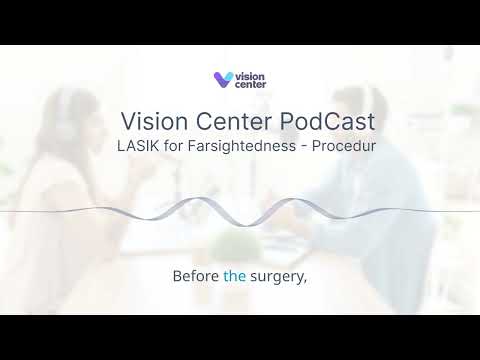LASIK is a highly successful laser eye surgery that improves vision quality and reduces the need for corrective lenses. LASIK surgery treats common refractive errors, including myopia (nearsightedness) and astigmatism.
LASIK eye surgery is also very effective at treating farsightedness (hyperopia). This article covers everything you need to know about LASIK for farsightedness.
How Effective is LASIK for Farsightedness?
According to the Refractive Surgery Council, 99% of people who have LASIK achieve 20/40 vision or better.4 That’s good enough to see clearly without prescription glasses or contact lenses. More than 99% of LASIK procedures result in 20/20 vision or better.4
However, if both eyes are treated for distance vision after age 40, you’ll likely have to wear reading glasses for close-up work.
Is LASIK Better for Nearsightedness or Farsightedness?
LASIK is a refractive laser surgery that can treat nearsightedness, farsightedness, and astigmatism. However, it may not be the best treatment for age-related farsightedness caused by presbyopia.
Can You Get LASIK for Farsightedness?
Yes. Many people get LASIK to treat farsightedness, but not everyone is a suitable candidate.
In people with farsightedness, the eyeball is too short, or the cornea is too flat. This causes light rays entering the eye to focus behind the retina instead of directly on it. The result is blurry near vision and sometimes distance vision, too.
LASIK eye surgery improves vision by changing the shape of the cornea (clear dome in front of the eye). LASIK is effective at treating farsightedness caused by a misshapen cornea. It’s not an ideal treatment for correcting hyperopia caused by the shape or curvature of the lens.
What is Farsightedness?
Farsightedness, or hyperopia, is a refractive error that causes blurry vision when looking at objects up close. Around 10% of people in the U.S. are farsighted.1

Farsightedness is often present at birth. However, it can develop later in life as the eye’s lens becomes less flexible due to the natural aging process.
Age-related farsightedness is called presbyopia. It typically affects people in their 40s and older.
Who Should Not Get LASIK Surgery?
Although it’s often effective, certain people shouldn’t get LASIK. This applies if you:6
- Are in your early 20s or younger
- Are pregnant or breastfeeding
- Have had a change in vision prescription in the past year
- Have fluctuating hormones due to diseases like diabetes
- Take certain medications
- Have health conditions, such as autoimmune diseases
- Actively participate in contact sports
LASIK for Age-Related Farsightedness (Presbyopia)
Because presbyopia results from changes to the lens and not the cornea, traditional LASIK cannot help. But there’s another option.
Monovision LASIK for Presbyopia
Monovision is a type of LASIK surgery that corrects your dominant eye for distance vision and the non-dominant eye for near vision. Both eyes work together, allowing for clear sight at any distance.
Although monovision LASIK works for many people, some cannot adapt. Therefore, eye doctors typically recommend trying monovision with contact lenses before committing to surgery.8
LASIK Procedure: What to Expect Before, During, and After
Find an experienced surgeon to answer your questions if you’re considering LASIK. The exact procedure may vary from one person to another, but here are some general guidelines on what to expect.

Before LASIK
Before surgery, your surgeon will ask you to switch to wearing glasses if you wear contact lenses. Because contact lenses change the cornea’s shape, they could affect your LASIK results.
For the day of your procedure, arrange for transport to take you home, as you’ll be unable to drive. Also, don’t wear makeup or apply lotions or creams; your face and eyes should be clean and free from contaminants.
LASIK Procedure
LASIK surgery generally takes less than 30 minutes. First, you’ll receive a thorough eye evaluation. This allows the surgeon to take comprehensive measurements of your eye and cornea.
During the procedure, the surgeon will:
- Provide medication to help you relax
- Administer anesthetic eye drops so you don’t feel anything
- Use an instrument to hold your eyelids open once the eye drops take effect
- Use a soft corneal suction ring to hold the eye in position
- Cut a small, thin flap in the cornea by using a laser or microkeratome (surgical blade)
- Remove specific amounts of tissue and remodel the cornea with an excimer laser
- Reposition the flap back over the cornea, where it should stay in place naturally (there’s no need for stitches)
Aftercare and Recovery
After laser eye surgery, you may feel itching, burning, or discomfort in your eyes. Don’t rub or scratch them, as this can cause damage and disturb the corneal flap.
Your eye doctor may prescribe antibiotics and anti-inflammatory eye drops to prevent infection. It’s crucial to follow your doctor’s instructions carefully. Use preservative-free artificial tears, as your doctor prescribes, to prevent dry eye symptoms.
Most people experience clear vision within one day after their LASIK procedure.
Risks and Side Effects of LASIK Laser Eye Surgery
As with any surgical procedure, there are potential risks and complications associated with LASIK. These include:
- Dry eyes
- Glare, halos, and double vision
- Poor night vision
- Infection
- Excess tears
- Abnormal corneal tissue growth
- Vision loss or changes
- Under corrections due to removing too little tissue
- Overcorrections because of removing too much tissue
- Astigmatism due to uneven tissue removal
The main advantage of LASIK for farsightedness is that it can reduce or eliminate your dependence on corrective lenses or glasses.
However, it doesn’t always correct farsightedness perfectly. As a result, you may still need to wear prescription eyeglasses or contact lenses for some activities, such as driving at night.
Listen In Q&A Format
LASIK for Farsightedness: Procedure, Aftercare, Risks, and Costs
Vision Center Podcast
How Much Does LASIK Cost?
In the U.S., LASIK surgery costs approximately $2,200 per eye. However, the cost may vary depending on your specific vision issues and location.
Does Insurance Cover LASIK for Farsightedness?
Health insurance plans don’t typically cover LASIK because they don’t consider it medically necessary. They will cover less-expensive vision correction options, such as prescription glasses.
However, some vision insurance policies offer relevant benefits, such as discounts on laser vision correction procedures with specific providers.
Surgical Alternatives to LASIK for Treating Farsightedness
If you’re not a good candidate for LASIK, there are other treatment options, including:
LASEK
LASEK may be an option if you have very flat or thin corneas. Instead of a blade or laser, it uses an alcohol solution to soften the outer cornea layer. It can then be peeled back, and a laser reshapes the inner corneal tissue.
Epi-LASIK
Epi-LASIK is another option for people with thin corneas. This procedure involves using a plastic blade to lift and separate the epithelium from the inner cornea before a laser reshapes the inner tissue. A protective contact lens is inserted into the eye to aid recovery.
Phakic Intraocular Lens Implants
For severe hyperopia, phakic IOL implants are an effective alternative to LASIK. It involves implanting an artificial lens between the iris and cornea (or behind the iris) to improve the eye’s focusing power.
Refractive Lens Exchange Surgery
This procedure involves removing the eye’s natural lens with a laser and then replacing it with an artificial lens. Refractive lens exchange is similar to cataract surgery. It’s an option for people with extreme hyperopia.
Summary
LASIK is a popular and effective type of laser eye surgery that treats refractive errors, including farsightedness (hyperopia).
LASIK can correct hyperopia caused by corneal shape or curvature. However, it’s not an ideal treatment for age-related farsightedness (presbyopia) due to lens changes. Monovision LASIK can treat presbyopia, but some people find it difficult to adapt.
People who get regular LASIK surgery after age 40 might need to wear glasses while reading, using a computer, or driving.
In this article








